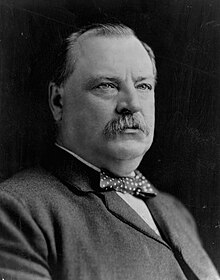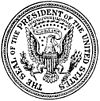
Back Kabinett Cleveland I German Première présidence de Grover Cleveland French הקבינטים של ארצות הברית בממשלי גרובר קליבלנד HE Presidenze di Grover Cleveland Italian Kabinet-Cleveland I Dutch
It has been suggested that this article be split into articles titled First presidency of Grover Cleveland and Second presidency of Grover Cleveland. (Discuss) (December 2024) |
 | |
| Presidencies of Grover Cleveland | |
| Party | Democratic |
|---|---|
| Election | |
| Seat | White House |
First term March 4, 1885 – March 4, 1889 | |
| Cabinet | See list |
Second term March 4, 1893 – March 4, 1897 | |
| Cabinet | See list |
|
| |
| ||
|---|---|---|
|
Personal
28th Governor of New York
22nd & 24th President of the United States
First presidency
Inter-presidency
Second presidency
Presidential campaigns
Retirement
 |
||
Grover Cleveland was president of the United States first from March 4, 1885, to March 4, 1889, and then from March 4, 1893, to March 4, 1897. The first Democrat elected after the Civil War, Cleveland was the first U.S. president to leave office after one term and later be elected for a second term,[a] and the only one to date to have served two full non-consecutive terms. His presidencies were the nation's 22nd and 24th.[b] Cleveland defeated James G. Blaine of Maine in 1884, lost to Benjamin Harrison of Indiana in 1888, and then defeated President Harrison in 1892. He was succeeded by Republican William McKinley, who won in 1896.
Cleveland won the 1884 election with the support of a reform-minded group of Republicans known as Mugwumps, and he expanded the number of government positions that were protected by the Pendleton Civil Service Reform Act. He also vetoed several bills designed to provide pensions and other benefits to various regions and individuals. In response to anti-competitive practices by railroads, Cleveland signed the Interstate Commerce Act of 1887, which established the first independent federal agency. During his first term, he unsuccessfully sought the repeal of the Bland–Allison Act and a lowering of the tariff. The Samoan crisis was the major foreign policy event of Cleveland's first term, and that crisis ended with a tripartite protectorate in the Samoan Islands.
As his second term began, disaster hit the nation when the Panic of 1893 produced a severe national depression. Cleveland presided over the repeal of the Sherman Silver Purchase Act, striking a blow against the Free Silver movement, and also lowered tariff rates by allowing the Wilson–Gorman Tariff Act to become law. He also ordered federal soldiers to crush the Pullman Strike. In foreign policy, Cleveland resisted the annexation of Hawaii and an American intervention in Cuba. He also sought to uphold the Monroe Doctrine and forced Great Britain to agree to arbitrate a border dispute with Venezuela. In the midterm elections of 1894, Cleveland's Democratic Party suffered a massive defeat that opened the way for the agrarian and silverite seizure of the Democratic Party.
The 1896 Democratic National Convention repudiated Cleveland and nominated silverite William Jennings Bryan, but Bryan was defeated by Republican William McKinley in the subsequent election. Cleveland left office extremely unpopular, but his reputation was eventually rehabilitated in the 1930s by scholars led by Allan Nevins. More recent historians and biographers have taken a more ambivalent view of Cleveland, but many note Cleveland's role in re-asserting the power of the presidency. In rankings of American presidents by historians and political scientists, Cleveland is generally ranked as an average or above-average president.
Cite error: There are <ref group=lower-alpha> tags or {{efn}} templates on this page, but the references will not show without a {{reflist|group=lower-alpha}} template or {{notelist}} template (see the help page).

